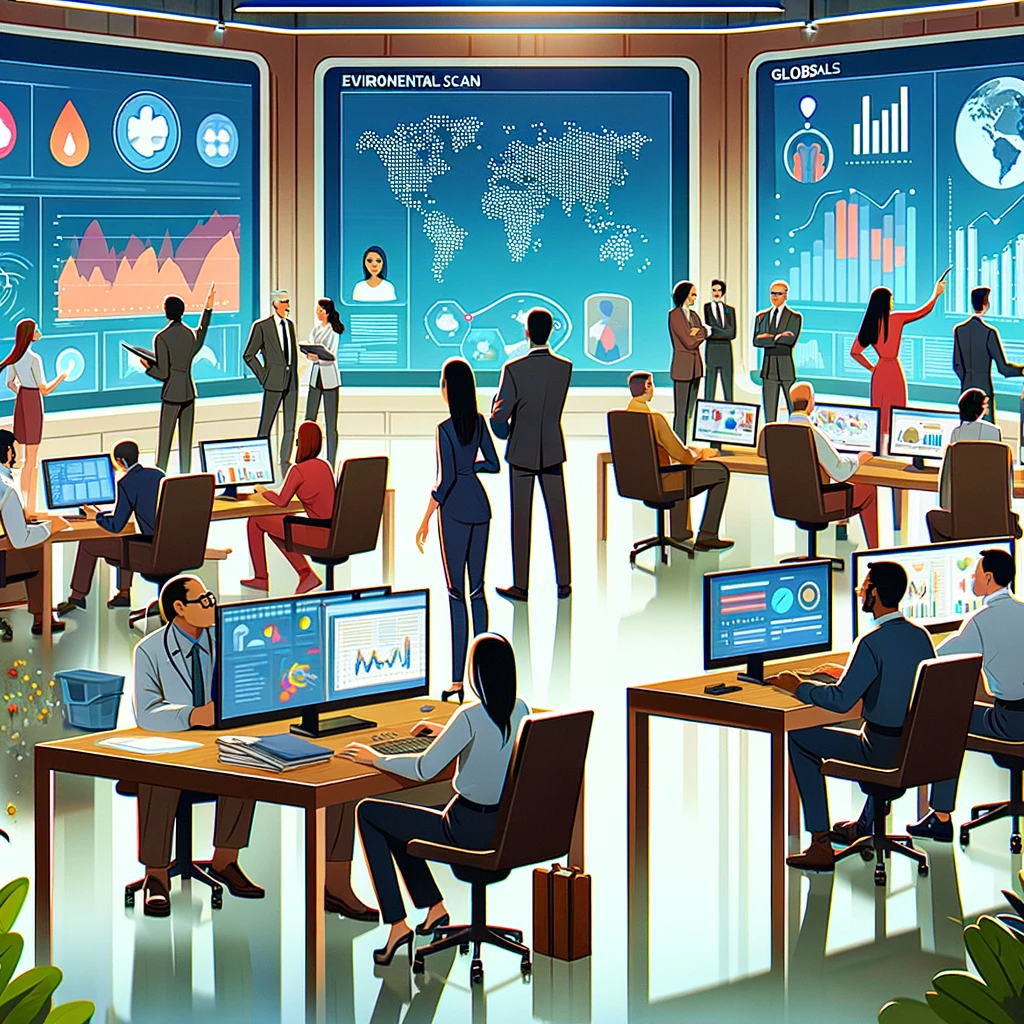
How to Conduct an Environmental Scan: A Guide for Public Health Practitioners
Last updated: 10/23/24. This has been one of our most popular posts, so I decided to revisit and improve it. — Jon
In public health, staying ahead of emerging trends and challenges is critical to developing effective strategies. One of the most powerful tools to achieve this is environmental scanning. This comprehensive method helps public health professionals identify opportunities, threats, and trends that impact their work.
In this guide, we will walk you through what an environmental scan is, how it differs from research synthesis, and why it is an essential tool for public health practitioners. By the end of this post, you’ll have a clear understanding of how to conduct an environmental scan and apply its insights to improve health outcomes.
What is an Environmental Scan?
An environmental scan is a method used to gather and analyze information about external and internal factors that affect public health. It involves systematically collecting data to identify trends, opportunities, and challenges in the health landscape. Public health professionals use this data to make informed decisions and create strategies that respond to the current environment.
Think of it as taking a snapshot of the world around you: understanding what’s happening now and anticipating future developments that might influence public health.
Key Components of an Environmental Scan
- Data Collection: This involves gathering information from various sources, including demographic data, health trends, policy changes, and socio-economic factors.
- Analysis: Data is analyzed to understand the implications for public health, considering factors like the prevalence of diseases, health disparities, and resource allocation.
- Interpretation: Finally, the data and analysis are interpreted to provide actionable insights for public health strategies.
By examining a range of data sources, environmental scans offer a holistic view of the factors shaping public health at any given moment.
Environmental Scan vs. Research Synthesis: Understanding the Difference
It’s important to understand the distinction between an environmental scan and research synthesis. While both are valuable tools, they serve different purposes in public health.
- Environmental Scan: Focuses on current trends and emerging issues. It’s forward-looking, capturing “what is happening now” and anticipating “what might happen in the future.”
- Research Synthesis: Involves a systematic review of existing research findings to address specific public health questions. It is retrospective, offering a look back at what has already been studied and concluded.
Both approaches are essential, but knowing when to use each one can help public health professionals respond more effectively to both immediate and long-term challenges.
Steps to Conduct an Effective Environmental Scan
Conducting a successful environmental scan involves several steps. Here’s how you can do it:
1. Define the Scope
Start by clearly defining the scope of your environmental scan. What are you trying to understand? In public health, this might include questions about disease prevalence, healthcare access, or the potential impacts of new policies. A well-defined scope will ensure your scan is relevant and targeted.
2. Gather Data
The success of an environmental scan relies on the breadth and depth of data you collect. Here are some key sources to consider:
- Government Reports and Public Health Data
Agencies like the CDC and WHO provide essential data on disease prevalence, vaccination rates, and healthcare access. - Legislative and Policy Documents
Keep up with health-related policies and regulations. Legislative changes can signal future public health challenges. - Health Surveys and Epidemiological Studies
Data from surveys like the BRFSS or NHANES offers insight into health behaviors and trends in different populations. - Peer-Reviewed Research
Academic journals are a rich source of up-to-date findings and reviews relevant to public health. - Media and Public Opinion
Stay informed on emerging health issues by monitoring news outlets and analyzing public sentiment through opinion polls. - Social Media and Online Trends
Platforms like Twitter and Facebook provide real-time information on public health discussions and concerns. - Collaborative Networks
Engaging with other health professionals and non-governmental organizations (NGOs) can provide unique data and insights.
By pulling data from diverse sources, you ensure your environmental scan is comprehensive and captures both broad trends and niche issues.
3. Analyze Trends
Once you’ve gathered the data, it’s time to analyze it. Look for:
- Patterns: What are the recurring themes across your data sources?
- Correlations: Are there relationships between different variables, such as health disparities and healthcare access?
- Unexpected Results: Identify any surprises that could signal emerging issues.
Your analysis might involve statistical methods or qualitative approaches, depending on the type of data collected. The goal is to pinpoint the factors that will most affect public health moving forward.

4. Interpret and Apply Findings
Next, interpret your findings in the context of public health. What do these trends mean for health outcomes? What opportunities or threats do they present?
For example, if your scan reveals that healthcare access is declining in a certain area, it may be time to advocate for policy changes or resource allocation to address the disparity. The ultimate aim is to turn data into actionable insights that inform public health strategy.
5. Report and Communicate Findings
Finally, communicate your findings to stakeholders in a clear and actionable way. Whether through presentations, reports, or executive summaries, effective communication ensures your environmental scan informs decision-making at all levels.
Make sure your report includes recommendations based on the data and presents the information in a way that is easy to understand for both public health experts and non-experts.
Best Practices for Conducting an Environmental Scan
- Use Diverse Data Sources: Rely on a variety of data sources to ensure a complete picture of the public health landscape.
- Stay Objective: Ensure objectivity in data collection and analysis to avoid bias.
- Update Regularly: The public health environment is constantly changing. Regular updates to your environmental scan will ensure you stay ahead of emerging trends.
- Collaborate with Others: Engaging with colleagues and other stakeholders can provide fresh perspectives and valuable insights.
Conclusion: The Power of Environmental Scans in Public Health
An environmental scan is an invaluable tool for any public health professional aiming to stay ahead of the curve. By systematically gathering and analyzing data from a wide range of sources, you can gain a deep understanding of the factors shaping public health today and anticipate the challenges and opportunities of tomorrow.
In contrast to the retrospective nature of research synthesis, environmental scans provide a dynamic and forward-looking approach, making them essential for strategic public health planning.
Start incorporating environmental scans into your public health practice today and take the next step toward more informed, effective, and responsive public health strategies. For more tips and tools, subscribe to our newsletter and stay updated on the latest trends in public health!



